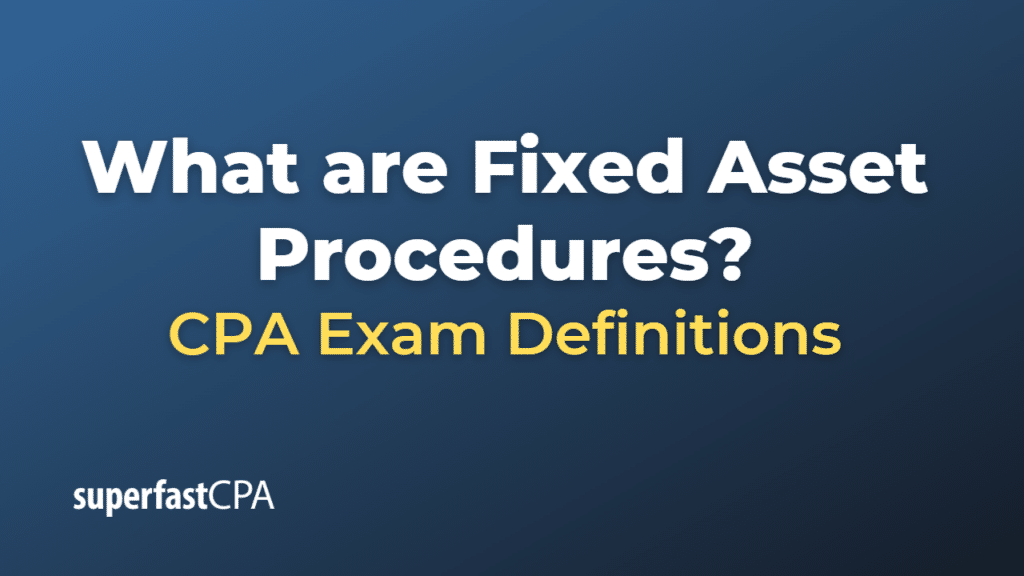Fixed Asset Procedures
Fixed asset procedures are the specific steps or actions that a company takes to manage its fixed assets in line with its fixed asset policy. The goal of these procedures is to maintain accurate records of the company’s assets, ensure appropriate use and maintenance, and accurately reflect the value of these assets in the company’s financial statements. Here are some common fixed asset procedures:
- Asset Acquisition: When a company acquires a new fixed asset, it records the details of the asset in its fixed asset register. This includes information such as the asset’s description, purchase date, cost, and expected useful life. The company also decides on an appropriate depreciation method for the asset.
- Asset Tagging: The company assigns a unique identification number or barcode to the asset, often in the form of a tag or label affixed to the asset. This helps the company track the asset and match it to the records in the fixed asset register.
- Asset Depreciation: The company calculates and records depreciation on the asset over its useful life. This reduces the asset’s value in the company’s books and reflects the wear and tear or obsolescence of the asset over time.
- Asset Maintenance: The company performs regular maintenance on the asset to ensure it continues to function properly and to prolong its useful life. Maintenance activities and costs are often tracked as part of the asset’s records.
- Asset Verification or Audits: The company periodically checks its actual assets against the fixed asset register to ensure they match. Any discrepancies are investigated and resolved.
- Asset Disposal: When an asset is sold, scrapped, or otherwise disposed of, the company removes it from the fixed asset register and adjusts its financial records accordingly. The company may also need to calculate and record any gain or loss on the disposal.
These procedures help to ensure that the company’s fixed assets are properly managed and accounted for, which is important for accurate financial reporting and effective asset management.
Example of Fixed Asset Procedures
Let’s take a hypothetical manufacturing company, “ManufactCo,” and walk through how it might follow its fixed asset procedures when it purchases a new piece of machinery.
Step 1: Asset Acquisition ManufactCo purchases a new machine for $50,000. The machine has an estimated useful life of 10 years. The accounting department records the machine in the fixed asset register, noting its description, purchase date, cost, and expected useful life.
Step 2: Asset Tagging ManufactCo assigns a unique identification number to the machine and affixes a durable tag to the machine with this number. This number matches the one in the fixed asset register.
Step 3: Asset Depreciation The accounting department decides to use straight-line depreciation for the machine. This means the machine’s value will decrease by $5,000 each year ($50,000 divided by 10 years). This depreciation expense is recorded in the company’s financial statements annually.
Step 4: Asset Maintenance The machine requires regular maintenance to ensure its efficient operation. ManufactCo schedules and performs this maintenance as needed, and tracks these activities as part of the machine’s records.
Step 5: Asset Verification or Audits At the end of the fiscal year, the company conducts a physical verification of all its fixed assets. This involves comparing the actual assets (and their condition) with the records in the fixed asset register. Any discrepancies are investigated and resolved.
Step 6: Asset Disposal After 10 years, the machine has reached the end of its useful life and is no longer efficient to operate. The company decides to sell the machine for scrap for $2,000. The accounting department removes the machine from the fixed asset register and records a loss on disposal of $3,000 (the book value of $5,000 minus the sale price of $2,000).
Through these procedures, ManufactCo can ensure that it is effectively managing and accurately accounting for its fixed assets.













